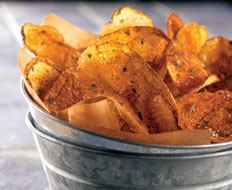Give away the razor, make back your money on the blades. Sell the hardware cheap; make your bones back on the software or subscription plan. Give away the online service; make your money on click-through or display advertising.
A variation on these ingenious loss-leader-like marketing strategies has a longstanding corollary in the fast food world: Offer the main course for a relative bargain and make up the difference with low-cost sides and drinks.
This tactic was, and largely remains, a compelling gambit for restaurant chains. But fundamental changes in consumers’ snack and side-dish preferences also suggest it may be possible to use sides to further build check totals, drive transactions, and create marketing-worthy buzz—without blowing the bank on food costs.
Before I delve into specifics, though, it’s worth asking what factors are affecting consumption of snacks and sides in 2011. In the course of developing new food products, we at the Center for Culinary Development spend considerable time working to determine the right levers restaurant chains and packaged-foods companies can pull to connect with customers. Based on recent research, we have identified three major drivers of snacking behavior today. None of them should come as a surprise, but they are nonetheless real and significant:
Portability: Being handy, handheld, neat to eat, and easy to transport are nonnegotiables in the snacking world today. If it can’t be consumed on the go, if it requires two hands to eat, or if it’s likely to splatter, spill, drip, or explode, it’s a nonstarter for today’s snackers.
Health and nutrition: Consumers are now motivated less by what their snacks don’t contain and more by what that cereal bar, yogurt cup, or nut mix does have going for it. Claims such as “sugar free,” “low fat,” and “reduced sodium” are generally less compelling than positive statements such as, “contains whole grains,” “rich in antioxidants,” and “heart-healthy.”
Taste: Snacks today are more than a basic bridge between meals. They have become gastronomic events that are anticipated almost as fervently as meals. Consumers overall are looking for an explosion of flavor and plenty of sensory excitement. Whether that excitement comes courtesy of an unusual ethnic flavor profile or an enticing texture—crispness or chewiness, for example—the important thing is that the snack be somehow memorable and worth the wait.
Demographics Drive Tastes
Although these three factors are somewhat universal, our deep dives into consumer snacking behaviors have revealed that each major demographic cohort has its own idea of what makes a snack irresistible. For 14-and-under “post millennials,” a snack’s color, shape, and marketing connections can be paramount, which explains the success of Yoplait’s Dora (the Explorer) yogurt and Disney’s flirtations with fruit snacks and crisps. Gen Y snackers tend to favor extreme flavors and textures. Gen Xers appear to be more intrigued by ethnic tastes. And Boomers are looking for health, wellness, and functionality—plus a little nostalgia—in their snacks and sides.
That’s a broad range of considerations to take into account when developing new snacks and sides, but in my view, a few types of products or approaches to new products could touch on most of the major behavior drivers.
Chip away: The potato chip has proven itself a remarkably versatile and delicious snack food, but its decadence factor prevents it from being a snack that consumers—particularly Boomers—can feel great about eating. Vegetable chips, by contrast, can deliver much of the same satisfaction with at least a small nutritional boost. Variants made from sweet potatoes, rice, beans, taro root, and even kale (all of which are now likely on grocery shelves somewhere near you) are worth a look.
Think comfort and indulgence, French-Canadian style: High-end chefs have lately turned to a Quebecois street-food favorite, poutine, for inspiration. This sloppy mix of french fries, cheese curds, and gravy is turning up in unexpectedly fashion-forward places, where some foodies have embraced it with relish.
But more healthful variations are possible: chickpea or sweet-potato fries can be substituted for standard versions. A hummus dip or lighter ricotta sauce, for example, could stand in for the traditionally heavy helpings of cheese favored by French Canadians.
Fresh twists: Perception is king, and tossing fresh herbs onto everything from sauces to salad dressings to fries, chips, and mac and cheese can impart an entirely new, piquant flavor profile to virtually any dish. What’s more, that freshness translates to quality to consumers.
The same goes for fresh fruit: Making fresh berries, apples, or other seasonal fare available as a dessert topping, or even as a soft-drink addition (think: agua frescas, those simple-but-succulent Mexican refreshers) can go a long way toward distinguishing your offerings from those of your competition.
Artisan flourishes: As I discussed in a recent column, the uniformity and consistency of quick-serve food has long been one of the category’s hallmarks. Today, however, quality-conscious consumers are coming to view the quirky inconsistency of artisanal breads, cheeses, pastries, and other foods as a signifier of careful craftsmanship.
Think, for instance, how much more handmade french fries appear when they retain a bit of skin. Taking steps to ensure that burgers, sandwiches, pizzas, tacos, and other foods vary in shape and configuration, if not weight or volume, could be a way to make snacks, sides, and even main courses carry a bit of handmade cachet.












